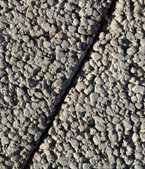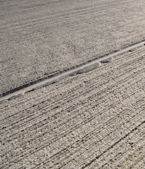Inside Iowa State
Inside ArchivesSubmit newsSend news for Inside to inside@iastate.edu, or call (515) 294-7065. See publication dates, deadlines. About InsideInside Iowa State, a newspaper for faculty and staff, is published by the Office of University Relations. |
Oct. 6, 2006 Concrete test lot introduces green option to campusby Anne Krapfl Imagine concrete that comes down the chute not like cake batter, but more like a (heavy) Rice Krispies treat. It contains large pebbles and lots of air, and work crews use a large roller to press it into a parking lot. Another roller, with pizza cutter-like qualities, cuts joints in what's called "pervious concrete" before it hardens. Iowa State is building such a parking lot, on a test basis, in the north part of campus, just west of the library storage facility. For the record, it's Lot 122. It's a cooperative effort between facilities planning and management and the parking division of the department of public safety -- the usual players in campus parking lots; civil, construction and environmental engineering extension; and environmental health and safety. For testing purposes, half of the 34-stall lot is standard concrete. The other half will be two slightly different recipes of pervious concrete so researchers can study variations in performance among all three. A green effortThe pervious concrete concept offers a solution to rainwater runoff that is better for the environment than the usual phenomenon of water -- containing pollutants from the lot surface -- rushing into gutters and down storm sewers to local creeks, where the banks erode from the sudden onslaught of water. The porousness of the concrete allows water and pollutants to drip through it -- not run off it -- to the ground below, where soil serves as a natural filtering agent to remove oils, salt and chemicals. Ideally, the water percolates all the way down to replenish the water table. At the very least, it's cleaner and diminished in velocity when it hits a storm sewer. "For years, Iowa State has been looking at ways to improve how we handle storm water run-off," said Doug Houghton, manager of the parking division. "Rain gardens are part of that experiment, and this porous concrete is, too." At the same time, sustainability and environment-friendly options have become a goal in FP&M, whether the project is new construction, renovation or parking lots. FP&M landscape architect Nancy Surprenant is the project manager on the parking lot project. What is it?Pervious concrete has been used successfully in warmer climates since the mid 1970s, she said. But the repeated freeze-thaw cycle in an Iowa winter adds a variable that developers in, say, Georgia, don't have to contend with. That's where Extension civil engineer Stephen Jones comes in. For nearly two years, Jones and his research team in the Concrete Pavement Technology Center have been studying variations of pervious concrete that could work in this climate. Standard concrete is made from cement paste, limestone aggregate of an inch or less and medium-coarse sand. Pervious concrete differs in that the limestone pieces are smaller and more uniform in size and most of the sand is removed. Pervious concrete has enough void space in it to handle 300 inches of rain per hour, he said. "Our goal is an 18 percent void space, and the 5 to 7 percent sand content in the [Iowa] pervious mix adds strength and resistance to freezing and thawing, so that's what we worked on," Jones said. Another goal is to achieve a pervious mix with about the same compressive strength as standard concrete -- 3,500 pounds per square inch. Southern varieties of pervious concrete, containing virtually no sand, can withstand about 2,000 pounds per square inch. The standard freeze-thaw lab test for concrete? Saturate it with water, freeze it and let it thaw -- 300 times. Jones and his team have two varieties of pervious concrete they're ready to test in actual conditions. Out of the labLot 122 is being built with testing equipment in it and under it that will measure temperatures in the pavement, an aggregate sublayer and 60 inches of soil beneath it; as well as moisture levels in the soil subgrade to track water movement through it. The plan is to monitor the data for at least two years, at the same time observing the pervious concrete for wear, cracking or other problems. The team will test samples of the water that soaks through and runs off the lot to measure pollutants. "We'll use it like a regular lot," Houghton said. Employees who attend training sessions at EH&S will have dibs on the lot. When no training sessions are scheduled, EH&S employees will use it. The cost of pervious concrete is higher than traditional concrete because it's so new ($4,000 per stall compared to about $3,000 per stall). But those costs would come down if the concept is proven successful in cold climates, Surprenant said, and once concrete firms had invested in the new equipment. It could eventually become the less expensive option if it allowed developers to eliminate water intakes, storm sewers or retention ponds associated with traditional parking lots. In addition to being mixed differently and requiring different tools, the ground preparation and installation process are different. Under six inches of pervious concrete (the same depth, incidentally, as a standard concrete parking lot), is a fabric barrier topped by two inches of sand and 12 to 18 inches of clean river rock. The aggregate layer serves as a holding area for water passing from the pavement to the subsoil. It's all right to put salt on pervious concrete in the winter. Sand is taboo, since it reduces the effectiveness of the porous layer. A pervious concrete lot is vacuumed, not swept. This project ties in to Iowa State's outreach mission, Houghton said. "We'll find out if it works and tell Iowans what we learned. "It's a relatively small project and we're willing to take the risk on it. We have every reason to believe it will work. In Ames alone, we're looking at developing a regional mall and a Super Wal-Mart. Who knows, those developers might be interested in pervious concrete," he said. |


Pervious (above) and standard concrete. Photo by Bob Elbert. Quote"For years, Iowa State has been looking at ways to improve how we handle storm water run-off. Rain gardens are part of that experiment, and this porous concrete is, too." Doug Houghton, manager of the parking division WatchA demonstration pour of the pervious concrete will begin at 9:30 a.m. Thursday, Oct. 12, at the lot site (weather permitting). Parking is limited; people are advised to walk or take CyRide. |